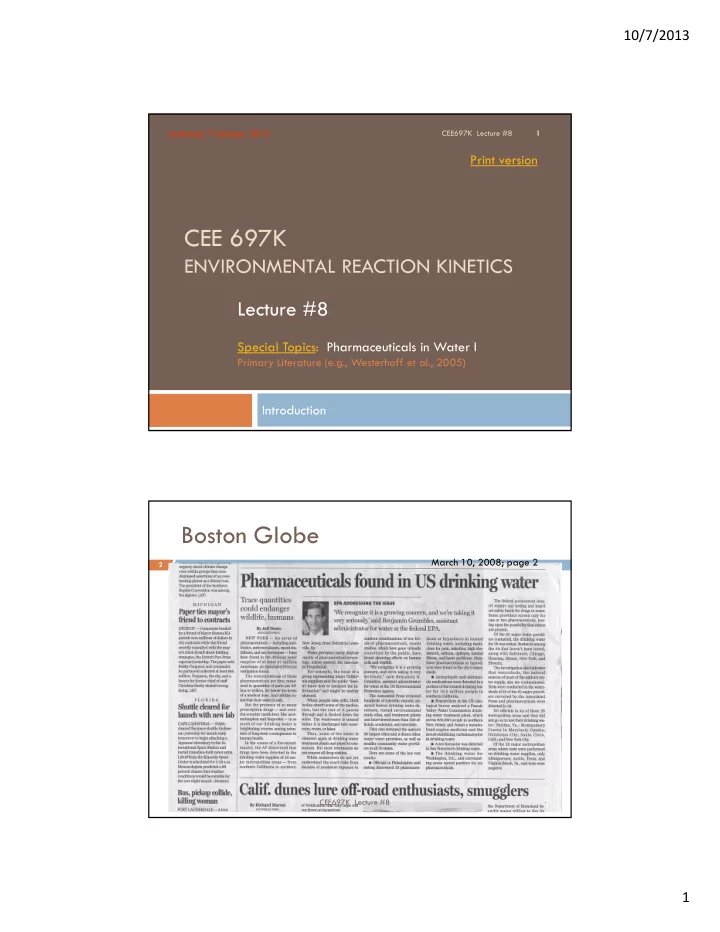

10/7/2013 Updated: 7 October 2013 CEE697K Lecture #8 1 Print version CEE 697K ENVIRONMENTAL REACTION KINETICS Lecture #8 Special Topics: Pharmaceuticals in Water I Primary Literature (e.g., Westerhoff et al., 2005) Introduction Boston Globe March 10, 2008; page 2 2 CEE697K Lecture #8 1
10/7/2013 EDCs and PPCPs 3 Why study these? Direct impacts on human health Maybe not the most important? Public perception Becoming a very sensitive issue Direct impacts on ecological health Well documented: feminization of fish, etc. Tracers of wastewater contamination Indicators & promoters of antibiotic resistance Precursors to more Hazardous DBPs CEE697K Lecture #8 WW Tracers 4 WW contributions: Near conservative PPCP tracers Primidone Others? Carbamazepine, caffeine, etc. Raw vs Treated: Chiral PPCPs Racemic mixtures that undergo enantioselective biodegradation Analysis of enantiomeric fractions may permit discrimination between raw and treated WW contributions Propranolol example: Fono & Sedlak, 2005 [ES&T] CEE697K Lecture #8 2
10/7/2013 Sources (2) 5 CEE697K Lecture #8 Primidone 6 Krasner et al., 2006 WQTC CEE697K Lecture #8 3
10/7/2013 Antibiotic Resistance 7 One of the most critical human health challenges of the 21 st century (WHO report) >1,000,000 Americans infected each year 14,000 deaths annually Cause: antibiotics are everywhere Up to 95% of antibiotics in US are excreted in an unaltered state Over prescription in humans Heavy use in agriculture Result: Antibiotic resistant genes (ARGs) are ubiquitous in the aquatic environment e.g., Pruden et al., 2006 [ES&T] CEE697K Lecture #8 Precursors to NDMA?? 8 NDMA (nitrosodimethylamine) CH 3 CH 3 HOCl is a very potent probable HN ClN human carcinogen CH 3 CH 3 Formation of NDMA from DMCA chloramination of DMA dimethylamine (DMA) NH 3 Not enough DMA to account for anything much NH 2 Cl NDMA formation is much higher in municipal WW than in pristine natural waters CH 3 CH 3 Major precursor is not CH 3 H 2 N N N NH 2 Cl natural??? ON N CH 3 CH 3 CH 3 NDMA UDMH CEE697K Lecture #8 4
10/7/2013 The Unnatural Precursor? 9 Ranitidine (Zantac) 63% conversion to NDMA Schmidt et al., 2006 [WQTC] Introduced in 1981, largest selling prescription drug by 1988 Stomach ulcers and esophageal reflux Mean concentration of 3000 ng/L estimated for raw municipal WW (national average) Sedlak 2005 AWWARF report 450 ng/L formation in raw WW expected Unknowns: how much does this persist in treatment and in the environment? CEE697K Lecture #8 USGS Survey 10 138 stream sampling sites Kolpin et al., 2002 CEE697K Lecture #8 5
10/7/2013 Removal by coagulation & disinfection/oxidation 11 Coagulation Generally no Nearly all EDCs and PPCPs are too small or too low in functional group density to be susceptible Oxidation/Disinfection Yes to some Chlorination: primary amines and activated aromatics (especially phenolics) and activated aliphatics Ozonation: Many aromatics; aliphatics if hydroxyl radicals are formed Oxidation & Biofiltration Almost nothing is known CEE697K Lecture #8 12 Ozonation Removal by ozone CEE697K Lecture #8 Westerhoff et al., 2005 [EST 39:17:6649] 6
10/7/2013 13 Selected Compounds EDC PhAC WW associated 17 -estradiol Atorvastatin or Nitrosodimethylamine Gemfibrozil Estriol Naproxen Estrone Sulfamethoxazole 17 -ethinylestradiol Trimethoprim Perchlorate Atenolol Ranitidine Primidone? CEE697K Lecture #8 Beta-Blockers: Atenolol 14 Atenolol is a representative of the group of Beta-blockers, for treating cardiovascular disease. This particular drug has been in use since 1976. Sedlak and co-workers (2005) estimate a nationwide average raw municipal wastewater concentration of about 1500 ng/L. This compound is rather unreactive with free chlorine, as it lacks activated aromatic structures as well as reactive nitrogen sites. It does not appear to have been tested for reaction with ozone May be used as an indicator of treated vs raw WW as propranolol was by Fono & Sedlak CEE697K Lecture #8 7
10/7/2013 15 Site of proposed attack on Atenolol by Chlorine and some Degradation Products (from DellaGreca et al., 2009) CEE697K Lecture #8 16 Proposed reaction pathway for atenolol and hypochlorite. Boxed structures represent isolated products. Bracketed structures represent proposed reaction intermediates. (from DellaGreca et al., 2009) CEE697K Lecture #8 8
10/7/2013 Statins: Atorvastatin 17 This compound is more commonly known as Lipitor, and it is representative of a larger group of cholesterol-reducing drugs called statins. It does not appear to have been tested for removal by coagulation or reaction with either chlorine or ozone. Based on its structure, we would expect it to be slightly reactive with ozone, but little affected by the other treatments CEE697K Lecture #8 18 Presumed oxidative degradation pathway of atorvastatin; From: Kracun et al., 2009. CEE697K Lecture #8 9
10/7/2013 19 To next lecture CEE697K Lecture #8 10
Recommend
More recommend